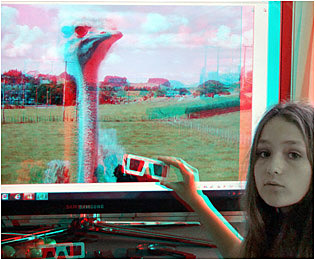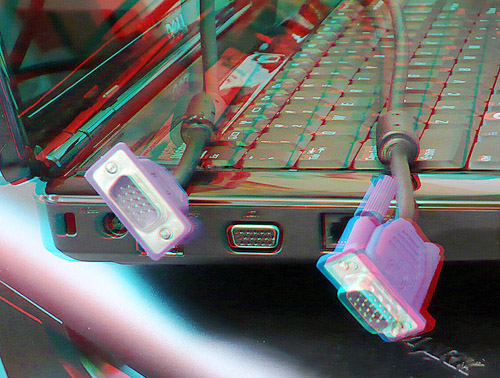


|
|
|
|

|
|
There is often a presumption that 3-D is trying to replace the 2-D mediums. You will hear comments like "Do you expect people to sit there and wear glasses to see it?" You may then reply "No they won't have to sit." 3-D will always require more image preparation and a display method of channelling or separating the left and right views. The efficiency of the channelling is crucial for stereoscopic imaging. Each eye should have its own exclusive view. Anaglyphic imaging is the most versatile, cost efficient and achievable 3-D format. With anaglyphic imaging, colors that are spectrally opposed are suitable for displaying the left and right views of a stereo pair. Of the many combinations, a red color channel and a green-blue color channel provide the best combination of mutual extinction and color perception when viewed through red/cyan viewing gels. 30% Red with 59% Green and 11% Blue light mixed together make white light. This suggests a 30/70 brightness imbalance between R/G-B color channels but in practice it is not an issue. |
 Anaglyph of an anaglyph. Try (ACB) 3-D Viewers |
 In 2006 approximately half a million anaglyph paper glasses were distributed in New Zealand for the TV show 'Medium in 3-D'. These glasses were so transmissive that the poorly produced televised anaglyph image looked no different with or without
the anaglyph glasses! You could plainly see red through the cyan gel. The anaglyph glasses used for that show all over the world and other ineffective glasses like them, are still out there providing disappointing 3-D viewing no matter what is looked at. If you have a pair of those Medium 3-D glasses, set fire to them.
In 2006 approximately half a million anaglyph paper glasses were distributed in New Zealand for the TV show 'Medium in 3-D'. These glasses were so transmissive that the poorly produced televised anaglyph image looked no different with or without
the anaglyph glasses! You could plainly see red through the cyan gel. The anaglyph glasses used for that show all over the world and other ineffective glasses like them, are still out there providing disappointing 3-D viewing no matter what is looked at. If you have a pair of those Medium 3-D glasses, set fire to them.
|
|